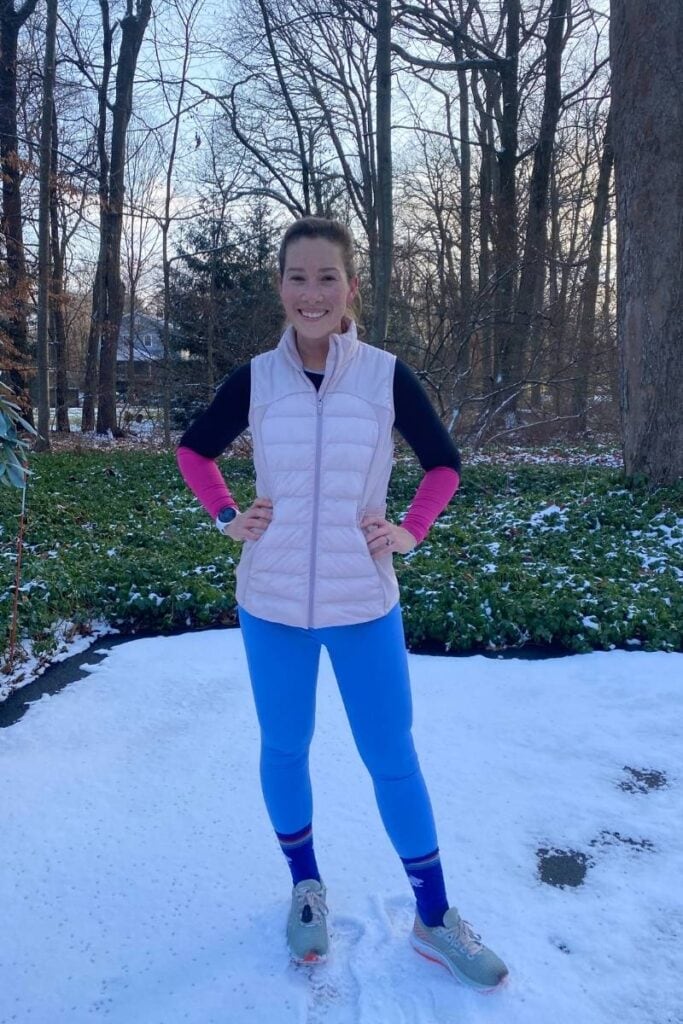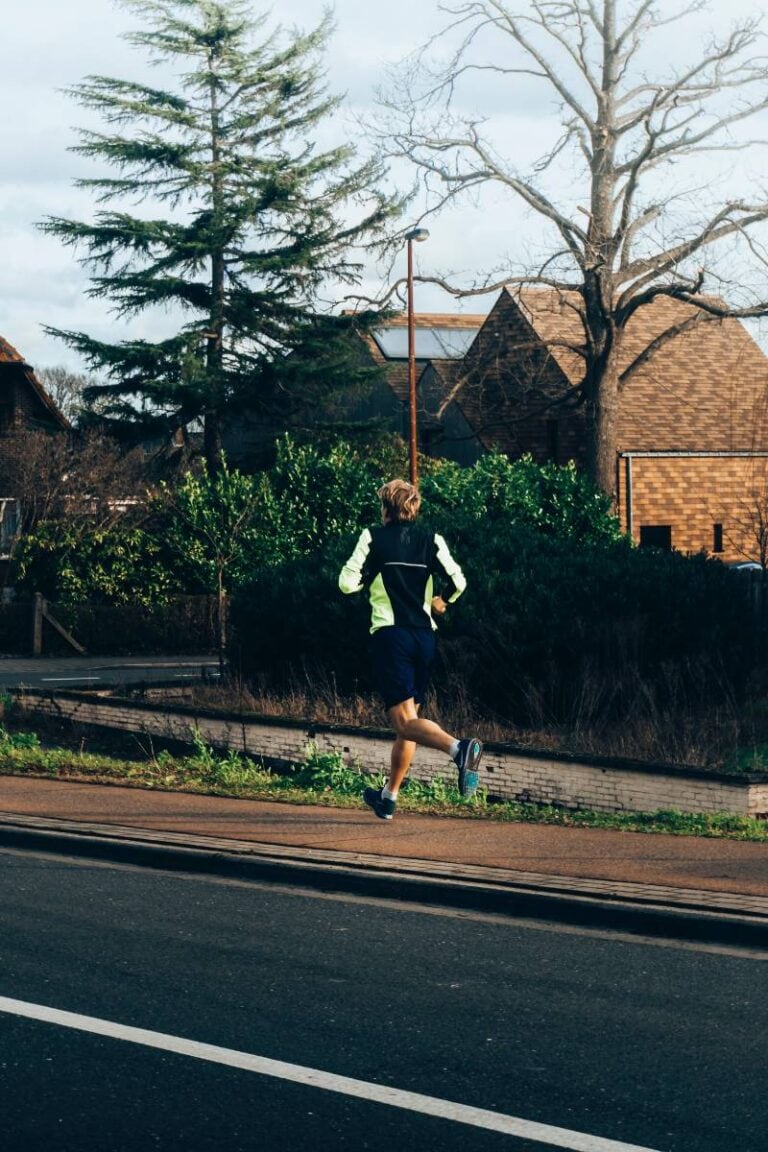Running in Cold Weather: Everything You Need to Know
Don’t let chilly temperatures keep you inside! This guide breaks down all you need to know for successful running in cold weather. Get ready to train well and crush your spring race while staying warm, safe, and having fun.
What should I wear while running in cold weather?
Wear protective gear
The first and most important cold weather running tip is to wear protective gear. With snow, ice, and slush, slipping and falling can easily injure a runner in a matter of seconds.
Keep yourself safe and protected this winter. Consider getting a pair of nanospikes if you live anywhere that typically gets snow. Kahtoola NANOspikes are a great option. They slip over your sneaker and grip the snow and ice to make sure you don’t fall mid stride. Yaktrax also makes traction cleats to slip over running shoes.
If you are running in the morning or evening, wear a reflective vest and headlamp. Because there’s limited daylight, these tools allow you to see and be seen by other people and cars. The Noxgear Tracer360 Reflective Vest has multiple colored light options on both the front and back plus reflective straps.
Options for headlamps include Petzel Tikkina and Black Diamond.
Related: 9 Common Winter Running Mistakes (And What to Do Instead!)
Dress warmly and in layers
Keep in mind that cold weather running is exactly that – cold! Make sure the layer immediately on top of your skin is moisture-wicking so your sweat is quickly absorbed.
Wear gloves, a buff, hat or beanie, and windproof jacket and know that you can always take layers off if you get warm. A warm core helps keep your extremities toasty and a cold core can often lead to chilly and numb fingers and toes.
Something else to keep in mind is to wear colorful clothing. With the bare trees and snow, there’s a lot of grey outside. Make yourself pop with a brightly colored hat, jacket, and leggings.
Related: What to Wear for Cold Weather Running
Is there anything I should do before leaving for my run?
Plan ahead and be flexible
If you are running outside, plan your route before leaving. If you know a sidewalk, pathway, or trail has not been shoveled or plowed, brainstorm alternative routes.
Also, avoid running through water and puddles. A lot of puddles during the winter are runoff from snow. If your feet become cold and wet, you can start to lose body heat quickly. If you think you might run through water, carry dry socks with you and change as soon as your feet become wet.
Related: Tips for Running in the Rain – 7 Ways to Crush a Rainy Run!
Stay aware of cars and ice
Hopefully drivers see you with your colored gear, reflective vest, and headlamp on, but unfortunately, that’s not something you can count on. Look ahead to see approaching cars and every so often, look behind you to see what’s going on. Staying alert is particularly important if a car hits a patch of black ice.
Be sure to scan the road for ice as you’re running. If you’re running on snow, plan ahead with your footing and make sure you land on something that looks supportive.
Utilize a treadmill
Remember that cold weather can often bring treacherous elements. If it’s snowing or icy, the temperatures are below zero, or the snowplows are out, you may want to consider switching your run to another day or running on a treadmill if you have access to one.
A treadmill is a great tool to use especially when it provides a safer setting than running outdoors.
Related: How To Run on the Treadmill: Best Tips and 5 Benefits
How does the cold weather affect my running?
Adjust paces and expectations
If you are running in winter, you give more effort running on snow than on dry terrain, especially if the snow is not completely packed down. Additionally, your body works harder when it’s colder to keep your core temperature up, which can make paces that typically feel easy in the fall feel much harder in the winter.
Whatever pace you’re running, turn your attention to an effort based run as opposed to pace based. Don’t fret if your pace is a few seconds slower per mile. What matters most is that you give the appropriate effort for that day.
Related: Rate of Perceived Effort Guide
Warmup properly
Ideally, it’s best to do a dynamic warmup before starting a run in the cold, especially if you have a speed workout or long run planned. As always, avoid static stretching before a run.
Some dynamic stretches include:
- Leg swings
- Frankenstein
- Butt kicks
- High knees
- Hip openers
- Hamstring sweeps
Related: Glute Activation Warm Up – 5 Best Exercises and Benefits for Runners
What should I do after finishing a cold run?
Refuel and hydrate
Runners may not feel as depleted and sweaty during and after a cold run, but our bodies still need water and electrolytes even during the chillier months. Hydrating is easily overlooked during winter because our thirst is suppressed. Carry fluids on long runs and speed workouts just like you would during the summer months.
Also, continue to jumpstart your recovery with a snack or meal with carbohydrates and protein.
Related: Fueling for Running – How to Fuel and Why It’s Important
Change into dry clothes
Put on warm and dry clothes immediately after completing your cold weather run. If you are finishing your run somewhere other than your home, bring a new set of clothes and put them on as soon as possible.
You may also want to make a hot cup of tea to pair with your post run snack to help warm up your core.
Everything You Need to Know for Cold Weather Running:
The better you prepare yourself for cold weather running, the more successful your run will be. At first, it may seem like a lot of extra steps to add layers, put on protective gear, and plan your route, but safety is the most important thing. Happy running!
- Wear protective gear like Kahtoola NANOspikes and Noxgear Tracer360 Reflective Vest
- Dress warmly and in layers
- Plan ahead and be flexible
- Stay aware of cars and ice
- Utilize a treadmill
- Adjust paces and expectations
- Warmup properly
- Refuel and hydrate
- Change into dry clothes
Planning to Run a Spring Race?
I would love to help you reach your running goals! Email me at [email protected] or check out my Run Coaching Services page to learn more.
Comment below:
Have you ever run in the snow or cold weather?
What’s one piece of gear you always run with or wear during winter running?















